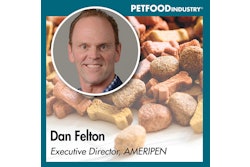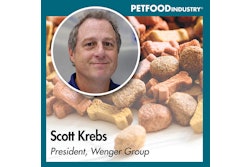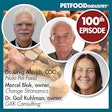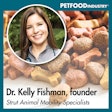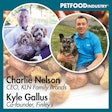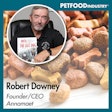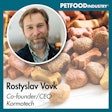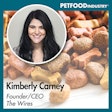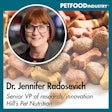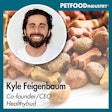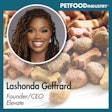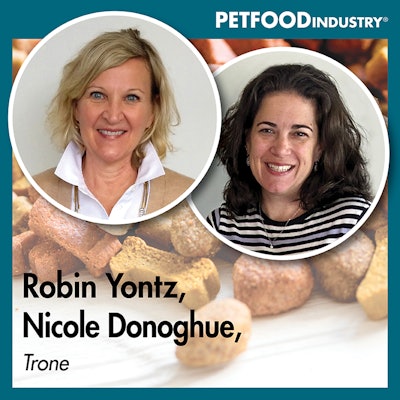
If you're in marketing and want to refine the push-and-pull of both staying true to your brand and satisfying the Google Machine, this one is well worth the listen. I went IN DEPTH with Robin Yontz and Nicole Donoghue at Trone on the topic. Tune in!
The below transcript is from Episode 48 of the Trending: Pet Food podcast, where I spoke with Robin Yontz, SVP creative director, and Nicole Donoghue, SVP account management, with Trone, about how a company can meet the needs of its brand as well as the technologies that drive online presence. You can find the episode at www.PetfoodIndustry.com/trending-pet-food-podcast, on SoundCloud or on your favorite podcast platform. This episode originally aired on November 8, 2023.
Lindsay Beaton – Editor, Petfood Industry magazine and Host, Trending: Pet Food podcast
Hello, and welcome to Trending: Pet Food, the industry podcast where we cover all the latest hot topics and trends in pet food. I’m your host and editor of Petfood Industry magazine Lindsay Beaton, and I’m here today with Robin Yontz, SVP creative director, and Nicole Donoghue, SVP account management, with Trone. Hi, guys, and welcome!
Robin Yontz – SVP creative director, Trone
Hi, Lindsay.
Nicole Donoghue – SVP account management, Trone
Hi, Lindsay. Thanks for having us.
Beaton: In case you're not familiar with my guests, here's what you need to know. During her 30 years in the industry, Robin has worked with both veterinary and retail pet products, creating successful branded campaigns and language. She works with creatives, brand planners and digital marketing specialists to make sure the brand voice is never lost.
Nicole has worked in retail advertising for 25 years with a focus on pet brands for 15 years. She has expertise in managing every channel of the marketing communication funnel with digital marketing strategy as her focus.
Trone is nationally known as a pet care marketing specialist. In business for 40 years, the company understands the dynamics of pets, pet owners, retailers and veterinarians. Trone has worked with some of the biggest and most highly regarded pet care companies in the U.S. and abroad, creating distinctive messages and insights for brands in the crowded pet marketplace.
Their specialties in brand voice and digital marketing are why I've brought both Robin and Nicole on today to answer this question: How can a company meet the needs of both their brand and the internet?
We are going to dive into a lot today about the sometimes-challenges, sometimes-opportunities that come up when you are both trying to build your brand voice and make sure that your brand voice is actually reaching the appropriate people, which can sometimes feel like two completely different things, I think. To start off though, I want to take a little bit of a wider view and just discuss how a company can know what approach or voice to take as a brand.
Yontz: That sounds like a simple branding question, but it actually is its own podcast, probably. First of all, back to this tone that complements your brand story: You need a voice that complements who you are. Your brand story needs to explain who your brand is and why your customer should care; your brand's why; its emotional and rational reason for being a brand in the first place. And that language and tone you choose should allow your brand to share its personality and inspire connections with like-minded people, you know, your specific audience. So, our brand stories, we like to make sure that they’re a tight 10 words. Now certainly there's longer versions of a brand story for inspiration, but by limiting that brand story to about 10 words it can be shareable; it's memorable so your internal team understands it, and maybe most importantly, your consumers can be eloquent brand ambassadors. So, from that story, you can develop your brand tone and your brand language set.
At the agency, we call that a “brand language palette.” And in your brand language palette, those are the words you're going to be able to use and are just as important as your brand colors and your logo. Just for an example, let's say you have a dog food that's exclusively for puppies. Your brand story would all be about the power of beginnings. A tagline and the language palette would be geared to growing strength or the power of starting out. Now, that sounds very straightforward when you describe it like that. But there's a study out that says 85% of companies go to the trouble of developing a brand voice and brand guidelines, but only 30% actually enforce that consistency. So back to tone and voice. Maybe your website is built on the guidelines, and that's great. But somebody puts a digital ad out or an online response to a customer, or even FAQs don't match that intended brand experience, all that can start to erode the brand. It's understandable how brands get off voice and off tone. If you work at a company and you work on the same brand every single day, and you're trying to stay consistent, you are tempted to try new things and new languages, and it's a real discipline to stay the course and be consistent year after year. But you do have to know your brand and live brand-first every day.
Beaton: There are so many companies in the pet food space, and there are only so many different types of messages that a pet food company can really get out there when it comes to what their product does nutritionally and what their product does for the human-animal bond. There is a thing in literature that says there are really only six or seven different plot lines for stories that exist in the whole history of literature and storytelling, and that everything that exists, every book on a bookshelf, is just a variation of one of those, say, six or seven themes. When you're talking about a specific industry — and everybody really has the same type of goal — where do you focus that brand messaging to actually stand out when you're really conveying a lot of the same things that all of your competitors are also trying to convey?
Yontz: If you're introducing a product, you have to believe you have a point of difference. No one goes into the marketplace saying, “Wow, I'm just another same,” right? So we dive down and find that insight, that motivating difference, and we really capitalize on that. And again, no one goes out to be “me too.” And even if they are “me too,” it's because they're less in price or have a more sustainable package. There's always some point of difference that someone cares about, and that's what we have to elevate. And again, back to that language, draw those language points up so that people can instantly find what that is. Because you're right, it's very confusing. But that is the challenge, and that's the beauty of branding.
Beaton: Let's say you have your brand voice down. You really know who you are as a company, you really know what you want to convey to pet owners, you have all that sorted. Now there's another issue: There's the fact that your brand needs to get out to your audience. And there are lots of different ways to do that these days. There's social media, there's more traditional marketing, you can still do commercials, you can do packaging, you can do all these different things. But there is a little something called Google, and a little thing called SEO and algorithms. And if you cannot find a way to work with those technological structures, all the branding, all the great messaging in the world is not necessarily going to get you in front of the right people. So I want to spend the bulk of our conversation now talking about how you balance the needs of your brand voice and your consumer with the demands of the Google machine. Where do you even start doing something like that?
Donoghue: It's a great question, Lindsay, and it's definitely something that is an interesting aspect of the marketing communication strategies. And while there's no universal formula for brand websites to achieve the right balance of searchability and memorability, as you just said, both are critical to making that lasting brand impression. And finding that balance can really make customers more likely to do things like create an account, finish checking out, sign up for updates or come back to purchase again. And so we believe [that] to be authentic and successful with improving branded organic search visibility, and really mastering that Google machine that you mentioned, the key is to combine foundational knowledge about both brand and SEO.
It's interesting. Google states, “Its automated ranking systems are designed to present helpful reliable information that's primarily created to benefit people, not to gain search engine rankings in the top search results.” Therefore, based on that statement, the combination of brand and technical acumen is imperative to ranking.
Though this is true, we all know, as marketers, that there is an algorithm that ranks the sites. And so to really test that algorithm, we do recommend that our clients consider some key questions about the content that they have on their site, and look at the technical setup of their site to make sure that they can truly be found by Google in the way that Google prioritizes its rankings. For instance, let's start with the brand. How can the brand look at itself and determine whether or not it's going to be successfully found by a search engine based on their statement of being a people-first content rather than a search-engine-first content? What does that mean? Well, people-first content brand asks themselves, “does the user find the content on the site useful? Have they learned something about a topic or a product? Will they feel satisfied by their visit?” Where in contrast, a search-engine-first site may not rank highly if you're using extensive automation to populate the site with keywords, or if the user comes to the site and is yearning for better information or more robust information because they don't feel like they get enough expertise from the site.
So as a brand considers and evaluates its content and how it presents itself, they may also ask themselves how to get to that good people-first content. So they could potentially say, “Okay, does the site's content answer valuable questions about the pet industry about the products that they provide? Or the company's philosophy? Does the site provide a memorable brand experience that would be well-trusted by the reader? How has the brand emotionally engaged with the audience to build loyalty over time, and does the information demonstrate that the writer or the brand knows the topic and is passionate about that topic?” So, these are all things that you can do that feel like they're subjective, but actually are considered as a part of Google's algorithm from a brand perspective.
So we want to consider that you're creating a site that has really rich content, good information and something that feels satisfying to the user. But at the same time, as I mentioned, we all know as marketers, there are technical things that you can do from an SEO perspective that are best practices to make sure that you're doing everything you can to create a technical foundation so that you can be found by Google easily. So if you put all that great effort into content and have a really great branded experience, and Google can't find you, then the effort does not work.
So, some of the things that we can think about as we are [considering] best practices — now, there's many technical recommendations, and again, that's why there's a lot of digital marketing specialists and SEO specialists that manage these strategies for clients. But there's a couple of key ones that are really basic recommendations that ensure that you can be found on the search engines. So, the first and foremost is making sure the site can be crawled easily and effectively by Google. Google crawls billions of pages, but there are some sites that can be missed if it's not set up properly. Once the site is crawled, a brand should be inspecting their content to determine how Google sees and renders that content. So that it's important for the brand to be perceived and found how you want the user to be able to find you. You can actually use an inspection tool to look at how Google is seeing your information. We also look at ensuring relevant and accurate page titles to connect the brand language that you want the search engines to see and find with that user. Another way is using meta description tags. These might be the easiest way for Google to use your page as those coveted snippets. Those are the things when you're searching online, and you see that question to an answer that pops up right at the top, that's called a snippet. And meta descriptions are a great way for Google to connect information that's informing the user in a short and relevant summary of what that particular page is about. It's kind of like an elevator pitch for the page, and it helps to connect Google with your brand and help you be the answer to really important search query questions.
A couple more technical things that help with search engine optimization setup is considering adding structured data to help the search engines better understand what's on the page and use the content in their search results. So what do I mean by that? So that's like a standardized way to provide information about a page and classify that page content. So for example, a standard way of explaining the ingredients in pet food, the benefits of the food, nutrition that's being offered and the serving size may benefit Google in connecting that information to a user's search query about pet food. Another example is for e-commerce sites: Product and review features really can benefit from structured data to ensure that when someone is searching, those product reviews go to the top of that search engine query. Also understanding that your simple navigation and your URL structures are really important to search engines and understanding the priority information that you want to serve on your site. And one of the most important things is to make your site mobile-friendly. This became a really big element of the algorithm a few years back, because the majority of users are searching on mobile devices, and so being able to create that same or better experience that they receive on a desktop on mobile is super important. And this can include anything from responsive website design, site speed, content organization for that smaller and on-the-go screen. So lots of ways to look at mobile-friendly creation. And that is a part of the Google algorithm and ranking you higher the search engine result.
That's a lot of different ways to really look at the technical aspect of your site and make sure that the search engines can really find you. But one of the recommendations that we have is to provide the balance our clients need between making sure the user feels the brand and Google finds the brand, is that we have both digital marketing specialists and subject matter expert copywriters reviewing the site content and providing insight into that strategy. A digital marketing specialist is looking to improve rankings and the subject matter expert is looking to differentiate through customized language. So together, they can really help a pet food or a supplement or a treat, as you mentioned before, stand out among those many competitors fighting for that daily share of that pet parent’s wallet, because it is a crowded marketplace, and being able to find yourself at the top of the rankings — in not only an interesting and relevant way, but a consistent way — is really helpful for you to stand out and to be perceived as a trusted product in the pet category.
Beaton: I want to talk more about the technical and content partnership, and the way you guys are set up there are technical people and content people working together to create this whole thing. And you guys have been in marketing for a while. Is it harder for a brand’s voice to come across as authentic when you have to take all of these technical aspects into consideration, or has the idea of authenticity evolved and refined the way it sounds to work around and within the technical capabilities that it also has to speak to these days?
Yontz: It is harder. I mean, there's no doubt about it. It's an extra layer of thought and consideration. Certainly, to Nicole’s point, you've got to put your audience and your user first. So that's what makes SEO work, that the brand wants to court this audience. But Lindsay, they're frenemies. Brand and SEO is like artistic meeting technical, passionate expression within rules. But both groups of people know we need one another to succeed, right? So back to the puppy food, and kind of to build on what Nicole was saying, both of these groups of people provide huge services. So the digital marketing people at our agency give us all these keywords and all these things to consider. And that's what they are, they're considerations, because some of the things that perhaps rank really high don't apply to this particular brand. So, discernment becomes the subject matter expert’s tool; they can discern based on the brand, based on the language and also knowing what the users are looking for. Because maybe if you have a brand-new product, people don't know how to find you, so you would have to use some keywords that maybe are not exactly on-brand, but you use that within your content to explain its newness, to give it a counterpoint.
These two groups of people have different objectives, yet the same end goal: One’s eyeballs and one’s inspiring connections. The big challenge is, from a creative perspective, not to bland the brand. Back to six stories, how are you standing out? You can't homogenize your brand with the gentleness. And frankly, back to Google. They frown on keyword stuffing anyway, just like creatives do, so we're very, very diligent and hard on our header one and header twos, these H1 and H2. We pair those with brand language palette words to make sure you're getting a brand expression and are easily found when the site's crawled. So again, that discerning eye is really about, “Is this helpful to our audience, and are they getting the experience?” but it's a lot of judgment calls. Also, you put too much consistency in the site and perhaps you lose out on a keyword.
So again, it's this balance. It's a lot of thought, because you can't create a consistent paragraph that gets placed several places on the site because Google might recognize that as duplicate content, so then you get no credit for it at all. So you've got to create these multiple chunks of copy written with both the brand and the SEO in mind. We really want to help our audience get there but we want that brand experience that's intended. So back again to our first question about voice and tone. The reason you need those is you need this strong language palette to wrap all these search terms in. If you don't, you're back to bland, not standing out. So these two word arts are really critical.
Beaton: I had always thought of marketing as an art, and it sounds like these days there's as much science included as there is art in marketing. I mean, there's always been an element of knowing the audience and understanding the way consumer minds work. But now with all this technical stuff that you have to take into consideration as well, it feels like to really, really have a solid marketing strategy and branding strategy, you have to be able to take the art form of language and the science of getting the message out there and merge them together. Is this a major challenge for some brands, to figure out how to balance the art and the science of it all? Or do people tend to want to go really hard one way or the other, and you kind of have to bring them to the middle somewhere, so that there's a nice balance to make everything work?
Donoghue: It is definitely a challenge. I think that it's interesting that you had mentioned kind of the art and the technical, it's actually the way that the construction of agencies and the teams have kind of evolved over time. We're pairing, as we kind of talked about, we're pairing writers with analysts, or we’re pairing brand strategists with digital strategists. And so if you have those two working together, ultimately success can be found. The challenge is making sure that there's consistency on both sides to make sure that you're basically keeping the other honest. Ultimately, that's kind of the challenge, because you can fall into too heavily branded and not seen enough, and too heavily technical and not engaging enough. So ultimately, it's that using the two with each other to really evaluate whether or not you're serving the exact audience with the message that you want them to see.
It's actually kind of interesting: There's an image that sometimes we show, it's like, what you see when you type in a question into Google, and what we see when you type into a question into Google, which is, the user sees a picture and a quick, short headline, and a real brief summary of what they want to get to, where the agency sees a code, and descriptions, and tags and all of this effort behind it. And I think that's the perfect visual for what should be accomplished in this challenge, is that the right user sees the right information. And if you look at evaluating or auditing what you have, you should be looking at both those views to determine whether or not that strategy is set up appropriately to answer that question.
Yontz: One more thing on that, back to what we're all doing together, there's a quote from Mad Men, from Don Draper. He says, “You're not artists, you’re problem solvers.” And that's exactly the end goal here, is analytical problem solving and technical problem solving or creative problem solving. In the end, that's what we're all trying to do is solve the problems for a brand and make sure that there are no problems for our audience.
Beaton: Since we're already talking about challenges, I want to know if there are some struggles that you see over and over again with brands you're working with. Are there things that are really sticking points for people, or things that companies or brands can consider that might be roadblocks for them?
Donoghue: I think that the interesting component that we see, I guess, on the consistency side is, keeping up with content is a dedicated task, and making sure that your website stays dynamic and up-to-date based on the algorithm rules and the brand extensions is really critical. And I think what we find most often is that SEO is in kind of the background of a marketing effort, and is not always the flashy, paid media campaign that's out in front of everybody. It's the long-term strategy that's behind, that really does need that ongoing, updating month-over-month, year-over-year, to see that consistency. And so I think one of the biggest challenges that we find is that ability to stay fresh, with fresh content, with interesting content, and to continue to do it in ways that really connect the brand not only to quality information, but also connect the brand to outside resources that also have quality information.
It does take intentional effort, and I think sometimes where the challenge is, is that other things come into priority and maybe are more up front for immediate and short-term gain. But keeping the eye on that long-term gain is definitely a priority. I think the other interesting battle that we often see or challenge is when we have digital marketing strategists that feel very strong about either a certain set of keywords or a certain kind of content that's going to really improve your keyword ranking. And then we have brand stewards that are really struggling with how to make that information make sense for the brand. And as Robin said, that is a creative problem-solving effort, but sometimes you have to give one way, sometimes it's just impossible to make both Google and the brand happy. And so you sometimes have to make a decision: Which is more important in this case? Where’s the 60/40, because it's not always 50/50, it's not everybody coming together and there's this harmonious collection of the data and the creative, but usually there's a compromise. And if something really needs to be emotionally driven, and really connected to build loyalty and trust with an audience, then the brand might win out a little heavier than the data. If you're really trying to move and be competitive on a particular keyword, then you might have to give up a little bit of that branding to make an H1 header be really specific to rank for that word. And it's all kind of unbalanced.
Beaton: Now, ideally, every company would have access to a content team, and a marketing team, and an SEO manager, and perhaps some IT people and all the different groups of people that would make this work seamlessly. But a lot of companies in the pet food industry do not have those kinds of resources. Obviously, we have the huge companies who have all the resources in the world, but I routinely talk to companies who have maybe 10 people on staff, the pet food arena is vast in terms of how many people exist in a successful pet food company.
What is a small company to do when there is all of this stuff that needs to be going on, and it's maybe being done by two or three people?
Donoghue: We work with companies that are startups that have the 10 people and all the way to the bigger companies that have a full staff. And so I think the key component, the thread between both the small company and the big company, starts with an intentional plan. Even at the smallest of companies, as long as your brand and your SEO efforts have a line item in your plan, and you make small steps towards these key things that we've talked about today, then it becomes a priority that gets done over time, rather than a priority that gets done all at once. The great thing about SEO and brand is you can build it over time; it's not an instantaneous success, you're not going to see your keywords jump up by 12 ranking points overnight. So if you can look at what those key successes are, and pick the things that you can do today — and we can talk a little bit about some of the top five successes, right, some of the things that you can really focus on that are not too overwhelming but can feel like small steps towards being seen and visible in your search engine rankings. Because it is overwhelming.
Everything we've talked about today sounds [like] a lot. But ultimately, there were some priorities that remain important to keeping both brand and SEO efforts on the forefront. As we've kind of talked about, developing that brand language palette to easily update content and match brand values as a site expands with new products and services in line extensions, for a small company that's where we can see a lot of drop off happen. They're in the middle of selling that new line extension or building that new product or determining the new packaging for new elements. They don't have time to be worrying about the SEO, about that right now. They're trying to do a lot of other things. But at the beginning of your efforts, if you can create this consistent way that, every time we have a new product, every time we have a new offering, we're going to do these couple of things, and at the very basic, if you focus on your Header 1 and Header 2 — which are nicely called by digital marketing specialists your H1s and your H2s — if you can focus on those and make sure that those match what you want the user to see and what you want Google to see, then that is a good step forward in gaining visibility through organic search.
Number two would be to set up your site to have branded content through on-page explanations and blog posts. So potentially invest, if you're a small company or a large company, invest when you start an evaluation of your website and doing some really well-trusted explanations of who you are and what you offer so that when you don't have time and things are busy, there's still this foundation for users to come back to that get that full feeling of what you're offering. For example, you may want to kick off an evaluation of your website and decide that you're going to do a series of blogs, you're going to dedicate some time and you're going to do three blogs. And those blogs are going to be focused on a particular topic that you think will stand the test of time. Robin mentioned a couple of times, like, puppy foods. So for example, if you were going into a service line of puppy food, you could create a blog series that answers the questions about the importance of nutrition to a puppy’s development, and that could answer over time that search query question of, “What kind of food do I give my puppy?” that connects the user to your brand and then converts them into a customer. What if you're busy six months from now and you can't get to another blog, that blog will still help to rank you for SEO. That's kind of a good way to think about it. So, small chunks of information that provide some ongoing reputation-building for your brand that makes you a well-trusted expert in the industry.
Another key thing that you can do, very simple to start with, is to look at a keyword ranking. And typically, you would have to connect with an agency or have a tool to be able to do this; there are some free keyword ranking tools out there. But for the real in-depth ones, you typically have to use a tool to look at that. And what you want to do, again, as a small team or as a big team, is pick keywords that have a lot of relevant and specific search volume to your part of the industry so that the traffic means something to your sales goals. Track these keywords and look at how your competitors track these keywords and where they rank, and that can really help you to figure out what the priorities are. The pet industry, as you mentioned, there are several really broad terms. Everybody wants to rank for what's the best pet food in the industry, right? And so if you do that, like for example, we've talked about puppies, and the best puppy food has a monthly search volume of 16,000. To rank for that, to be in number one position, you'd have to be working really hard to connect a lot of the things that we talked about today to rank for that. It's a really broad search term; it's a really hard one to rank for. But as a small company, what you might want to consider is that I'm not going to necessarily go after that broad search term, I might want to go after best puppy food for small breeds. It only has 2,500 monthly search volume and a lower competition set. So that might be more of a specific audience. So, look at those keywords and don't try to rank for all of them; pick a set that you can really rank for and just focus on those. Creating priorities make this SEO effort more attainable and not feel so overwhelming.
Then, from a technical perspective, you could look at your site. And linking strategies are important to the Google algorithm. And this can be something, again, that's simple for the small company or the large company, which is just to make sure that within your site you're connecting things. So, if you have a product page, and you've written a blog that's interesting to that product page, make sure that the product page links to your blog. Those kinds of strategies, showing that linkage between not only product information but also educational information or nutritional information, increases the level of your content and also increases your relevance to a search query. So it's interesting, when people look for questions Google wants to return answers, not products. So, by connecting a product to information and information to a product, you can ultimately then be returned on a search result for either a product search or question search.
And finally, as I mentioned at the start, is just recognize that SEO and brand are long-term commitments. So make reasonable monthly plans. Don't create a plan that says, “I'm gonna write 10 blogs this month, and I'm gonna get them all linked to industry magazines. I'm going to …” because ultimately it does take time. So as you think about your annual planning, and you think about the team you have and who you can have work on this, if you're a small company, you might be looking at one blog per month, looking at your 10 keyword rankings, and making sure that your H1 and H2 headers are in the right place. If you're a big company, you're looking at creating tons of content, optimizing your pages, looking at potentially 50 keywords and constantly updating your site to make sure that you're connecting with Google and visibility. It can be managed based on how you look at what you have available and the resources that are there.
Beaton: Success is going to mean different things to different companies depending on what their customer communication goals are, the size of the company, what their capabilities are. But I have to believe there are some elements that are probably similar among all the brands that you have had the most success with or seen succeed in the pet food space. So, whether or not you've been involved with them, or have helped them out or anything like that, what are some of the successes you've seen, and what are the common elements among these brands that really nail it in terms of finding this balance that we've been talking about?
Donoghue: I think the key successes that we see in the pet category — because the interesting thing about the pet category, pet food in particular, is so competitive, but the pet parents themselves are being infiltrated with so much information from companies. Because they're not just getting pet food information, they're getting treats, and toys and all sorts of elements of the pet industry. And so I think where we see the most success is where there is ongoing flexibility with what you are focusing on based on the user and how the brand can deliver what the user needs. And so it's that insight, staying on top of the insight in that ever-changing dynamic of this pet parent, and not just staying with, “I wrote this information on my site, and this is going to be the information that I keep for the rest of time because it makes sense to my product.” It's looking at that core information and then being on the ready to adjust based on how the pet parent views food and the nutrition that it provides to their beloved animals. I think that's where we see the most success, is those brands willing to stay the course with what their benefits are, what their core pillars are, and continue to be consistent in that and also be flexible.
It's a hard thing to do, because Robin just talked about: Make sure you have a brand palette and make sure you have language that is consistent and that you don't veer off of that. And you do really need to do it, but there's a lot of elements that go into standing out for pet foods. And ultimately, the ones that we've seen to be successful really find this relevant connection to an audience that makes them switch. Because ultimately, I think the biggest challenge is you're always pulling share. Unless you have somebody that is brand new, they just got a puppy for the first time, they just got a cat for the first time, and they've never been a pet owner in their lives. Okay, you might have some opportunity there to convince them. But most people that are purchasing in this industry have purchased something before. So, if we're trying to have them pull share or make a decision on a pet food that's being ingested by their animal, it needs to be really convincing and really relevant to them. And understanding what that user is looking for, and what that audience is looking for, ultimately makes that happen. And that's where the success is.
Yontz: The thing that is really not factored into this particular conversation with SEO and the brand is the environment. So, to Nicole's point, you have a raw food, and there's a trend or something that says raw is bad, raw is bad. You go out there and explain the benefits in response to the environment in a very educational way. And this education does prop up your brand, but there's always somebody … eggs. Eggs have been in, eggs have been out. Eggs have been in, eggs have been out, right? So that's a perfect thing for your blogs, to make sure they're really timely and responding to environmental influences. Because pet parents are so involved, and that's what we found, is they are readers. Pet parents are so involved, so they know what is trending down for their pets. So you've got to be on the ready with that information.
Beaton: Twenty years ago, I don't think anybody in marketing thought that it was going to be such a complex prospect today to just put together a solid brand messaging and get it out in front of consumers. How do you think this art and science, technology and content dichotomy is likely to continue to evolve? Are we sticking with this for a little while? Are there already new elements being added in that people need to be aware of?
Yontz: Well, certainly we can't see the future and things change daily. Even on a digital ad, the specs change constantly, all these algorithms. But the search engines are definitely going to have more and more influence, we know that. We know that this pet landscape is going to keep expanding because of all the products. So looking ahead, it seems like brands are going to start looking for shortcuts, right? What's the shortcut? Because what we've talked about today is super hard. It's a lot of thought in manual, right? It's all manual, a lot of discernment.
So you've got to think that people might use AI to help figure some of this out for brands. And that seems like a great idea at first, but AI would probably make your site really searchable and found. But when you got there, it would look like every other site that used AI to get there. It's a huge loss in branding. A couple of years ago, we started noticing that every brand online had dropped their beautiful logo font treatments and gone to a sans serif — we call it the great sans serification of the logos — and everybody looks the same. Even these really affluent brands dropped this gorgeous font that they had for 50 years or hundreds of years. This is a balance, and the dichotomy is going to keep trying to pull you apart. But the creative writing and storytelling is the hard part, because the algorithm is the algorithm. It’s going to change, but you're going to know what it is, right? It's going to be black and white. So this wrapping the brand story up is going to be really tough for people, and require a lot of dedication and a lot of problem solving.
Donoghue: Yeah, I mean, I think that ultimately, as we've kind of talked about, brand and SEO are both investments the companies need to make to build trust and loyalty with their audiences. And I don't think that's going away. Ultimately, we are all working to make the most satisfying experience for the sought-after pet parent, and that balance of brand and SEO is achievable if digital marketing strategy is put in place. With the continued improvements in analytics and the increasing cost of paid media, digital marketing is going to continue to be examined and segmented into valuable content for the user to find organically.
And the user is at the heart of all brand and digital strategies. And so when we think about the pet industry, and we have this crowded marketplace with so many new product entries every year, we do feel like working with digital and branding experts to determine that value of your brand will ultimately serve as the foundation for sound brand language and a successful searchability strategy that can keep up with the ever-changing digital landscape.
Between now and when this podcast airs there's going to be many changes. Things change every single day in the digital landscape, and it is a digital strategy’s responsibility to stay on top of that. At the heart of it is that's going to continue to move, and what we can do to control our visibility and searchability within the search engines is to make sure that we know who we are as a product. We know who we are as a company and what philosophies you want to put out there in the world. The rest of it is that discipline to do the technical aspects and stay consistent, but the hard part is figuring out what you want to say and how you want to say it and then make it happen.
Beaton: Well, I really appreciate you both taking the time to sit down with me today and try to wade through some of the hard parts, because I really think brands are doing their best to have a unique message and get that message in front of consumers, but I also have a feeling that it can feel mutually exclusive at times to people. So being able to hear how these two elements can and do work together even though it's more complicated than it used to be, even though things have evolved, can be really helpful for marketers and brand managers and data analysts and anybody who's really just trying to bring company messages together and get them out in front of the right people. So thank you guys for being on today to help me work through all of this. Before we go, I always like to do a little plug. Where can people find more information about you, as well as Trone?
Donoghue: Sure. Well, thanks for that. We would love for people to visit us at www.trone.com to learn more about our digital marketing and branding services, as well as our blogs on search memorability and brand consistency. Both Robin and I are on LinkedIn; you can connect with us there. And ultimately, we specialize in brand and SEO audits to evaluate how these sites meet the expectations we spoke about today. So, we'd love to connect with you and see if we can look at your current site and determine its brand and SEO balance.
Beaton: Excellent. That is it for this episode of Trending: Pet Food. You can find us on www.PetfoodIndustry.com, SoundCloud or your favorite podcast platform. You can also follow us on Instagram @trendingpetfoodpodcast. And if you want to chat or have any feedback, I'd love to hear from you. Feel free to drop me an email: [email protected]. Once again, I'm Lindsay Beaton, your host and Editor of Petfood Industry magazine, and we'll talk to you next time. Thanks for tuning in!





